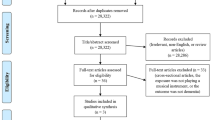Abstract
Background and aims: Cognitively stimulating activities appear to protect against the development of dementing illness — playing a musical instrument may be one of these activities. Consistent with this notion, the aim of this study was to explore the hypothesis that dementia might be less common among orchestral musicians. Methods: A cross-sectional survey of 23 older orchestral musicians who were former members of a single orchestra was carried out. Prior musical background, family history, and health history were obtained. A cognitive screen was administered in person or by telephone. Musicians were also queried regarding their awareness of living former orchestral colleagues with dementia. Results: The mean age of participants was 76.9±6.8 (SD). No participant was aware of a living former or current orchestral member with either reported or suspected dementia. Conclusions: The results are consistent with the hypothesis that dementing illness may be less among orchestral musicians — possibly from a lifetime engaged in a cognitively stimulating endeavor.
Similar content being viewed by others
References
Evans DA, Funkenstein HH, Albert MS, et al. Prevalence of Alzheimer’s disease in a community population of older persons. Higher than previously reported. JAMA 1989; 262: 2551–6.
Evans DA. Estimated prevalence of Alzheimer’s disease in the United States. Milbank Q 1990; 68: 267–89.
Ernst RL, Hay JW. The US economic and social costs of Alzheimer’s disease revisited. Am J Public Health 1994; 84: 1261–4.
McDowell I. Alzheimer’s disease: insights from epidemiology. Aging Clin Exp Res 2001; 13: 143–62.
Katzman R. Education and the prevalence of dementia and Alzheimer’s disease. Neurology 1993; 43: 13–20.
Friedland RP, Fritsch T, Smyth KA, et al. Patients with Alzheimer’s disease have reduced activities in midlife compared with healthy control-group members. Proc Natl Acad Sci 2001; 98: 3440–5.
Wilson RS, Mendes De Leon CF, Barnes LL, et al. Participation in cognitively stimulating activities and risk of incident Alzheimer disease. JAMA 2002; 287: 742–8.
Verghese J, Lipton RB, Katz MJ, et al. Leisure activities and the risk of dementia in the elderly. N Engl J Med 2003; 348: 2508–16.
Rauscher FH, Shaw GL, Ky KN. Music and spatial task performance. Nature 1993; 365: 611.
Rauscher FH, Shaw GL, Ky KN. Listening to Mozart enhances spatial-temporal reasoning: towards a neurophysiological basis. Neurosci Lett 1995; 185: 44–7.
Pantev C, Oostenveld R, Engelien A, Ross B, Roberts LE, Hoke M. Increased auditory cortical representation in musicians. Nature 1998; 392: 811–4.
Schlaug G, Jancke L, Huang Y, Staiger JF, Steinmetz H. Increased corpus callosum size in musicians. Neuropsychologia 1995; 33: 1047–55.
Schlaug G. The brain of musicians. A model for functional and structural adaptation. Ann NY Acad Sci 2001; 930: 281–99.
Mazziotta JC, Phelps ME, Carson RE, Kuhl DE. Tomographic mapping of human cerebral metabolism: auditory stimulation. Neurology 1982; 32: 921–37.
Munte TF, Altenmuller E, Jancke L. The musician’s brain as a model of neuroplasticity. Nat Rev Neurosci 2002; 3: 473–8.
Folstein M, Folstein S, McHugh P. “Mini-Mental State”. A practical method for grading the cognitive state of patients for the clinician. J Psychiatr Res 1975; 12: 189–98.
Evans D, Scherr P, Cook N, et al. The impact of Alzheimer’s disease in the United States population. In Suzman RM, Willis DP, Manton KG, Eds. The Oldest Old. New York: Oxford University Press, 1992: 283–99.
Sloboda JA. The Musical Mind. New York: Oxford, 1985.
Ericsson KA, Krampe RT, Heizman S. Ciba Foundation Symposium 178: The origins and development of high ability. New York: Wiley, 1990.
Khachaturian ZS. Toward a comprehensive theory of Alzheimer’s diseasechallenges, caveats, and parameters. Ann NY Acad Sci 2000; 924: 184–93.
Ross GW, Abbott RD, Petrovitch H, et al. Frequency and characteristics of silent dementia among elderly Japanese-American men. The Honolulu Asia Aging Study. JAMA, 1997; 277: 800–5.
Howe MJ, Davidson JW, Sloboda JA. Innate talents: reality or myth? Behav Brain Sci 1998; 21: 399–407.
Coon H, Carey G. Genetic and environmental determinants of musical ability in twins. Behav Genet 1989; 19: 183–93.
Author information
Authors and Affiliations
Corresponding author
Rights and permissions
About this article
Cite this article
Grant, M.D., Brody, J.A. Musical experience and dementia. Hypothesis. Aging Clin Exp Res 16, 403–405 (2004). https://doi.org/10.1007/BF03324571
Received:
Accepted:
Published:
Issue Date:
DOI: https://doi.org/10.1007/BF03324571




